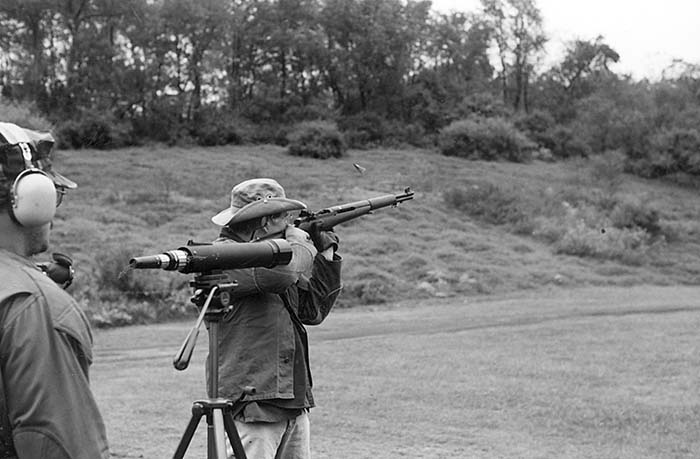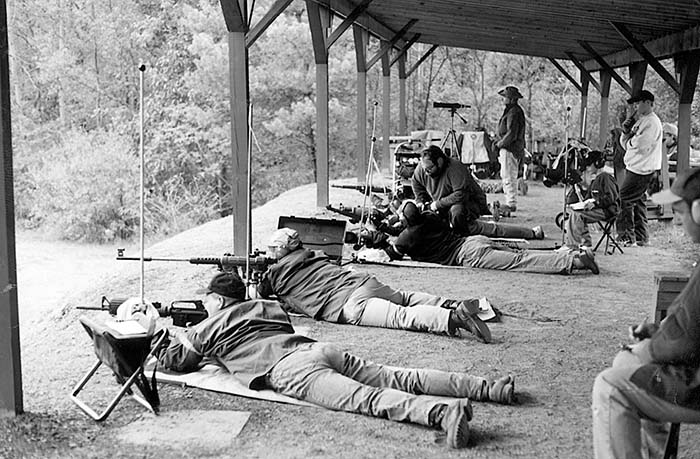By Frank Iannamico
A term often used in conjunction with U.S. military firearms is DCM, most commonly with the DCM M1 Garand Rifle. New collectors of military arms are sometimes confused by this term and the DCM program itself. This article is intended to explain the DCM program (now called the CMP) and how to obtain a genuine U.S.M1 Garand at a reasonable cost from government storage depots.

A Brief History of the M1 Rifle
Development of the M1 rifle began in 1919 just after the conclusion of WWI. The concept of a semi-automatic military rifle met with a lot of controversy and resistance by many conservative minded individuals. These individuals believed that a semi-automatic service rifle would create an ammunition supply problem, would not be accurate, and would be difficult to manufacture.
Fortunately for the United States there were many forward thinking individuals who believed in the concept of the semi-automatic service rifle, and development went ahead to find a suitable design. Unfortunately politics and the conflicting ideas of many of those involved in the project caused the program to drag on until 1936 when a suitable prototype finally evolved. The basic design was tinkered with until 1940 when large-scale production finally began. Most of the countries involved in World War II relied upon bolt action rifles, many of which were designed prior to World War I. With the modern semi-automatic M1 rifle the U.S. serviceman was the best-equipped soldier in the war.
John C. Garand created the M1 Rifle while he was working at the Springfield Armory. During World War II the M1 Rifle was manufactured by the government operated Springfield Armory and the private Winchester Arms Company. Over 4,000,000 M1s were manufactured from 1937 to 1945. Although the Germans and the Russians during the war fielded semi-automatic rifles, they could not compare to the reliable U.S. M1. The incredible M1 design was to have a service life extending long past the conclusion of World War II.
In 1950 the outbreak of hostilities in Korea brought many of the World War II M1’s out of retirement. Soon it was decided that more M1 Rifles would be needed, and plans were set in motion to resume production. During the Korean Conflict M1 Rifles were manufactured by International Harvester, Harrington & Richardson and the Springfield Armory. In the mid 1950’s about 1,400,000 additional M1 rifles were produced, and many more WWII era rifles were refurbished. Many World War II rifles had to be rebarrled due to the U.S. military’s use of corrosive ammunition during WWII.
Supply and Demand
The M1 Garand continues to be one of the most desired World War II era firearms by both collectors and shooters. Although the M1 Garand rifles are fairly common today it wasn’t always that way. In the 1960’s and 1970’s the M1s were quite scarce in the hands of collectors, and the guns were highly sought after. Welding together parts of M1 receivers that had been demilled by the government fulfilled part of the demand for the rifles. Several enterprising individuals performed this re-welding procedure and the quality ranged from poor to excellent. The problem was knowing which ones were good and which ones were not. The commercial Springfield Armory also produced new M1 receivers and rifles for shooters and collector who didn’t want to take a chance with a welded receiver.
In the mid 1980’s a new trade protection bill was signed into law. A rider, REC S2234, was attached to the bill that would allow weapons on the Curio and Relics list to be imported into the United States for the first time since 1968. This caused a huge influx of M1 Garands, carbines and other military weapons. The condition of these weapons ranged from good to poor. This created a whole new category of collector firearms named “recent imports”. Many purist collectors snubbed the recently imported weapons, mainly because the new law allowing their importation also required the importer’s name to be stamped on the barrel. Some importers did a very nice job making the import stamp as unobtrusive as possible, while others made them as large and unsightly as could be imagined.
Still another popular source for obtaining U.S. issued firearms was the DCM or the Director of Civilian Marksmanship Program. The DCM had 1903 rifles, 1911 pistols and eventually M1 Garands all at reasonable cost, and in serviceable condition ranging from good to excellent. The condition and manufacturer of the M1 rifle received was pure chance. Prices for these weapons in the past have been a real bargain. Until recently M1 Garand rifles could be purchased for $165.00!

The CMP Program
The DCM program was changed in 1996 to the CMP or the Civilian Marksmanship Program. Up until 1996 the U.S. Army administered the program that originally began in 1916. The mission of the CMP program is to promote firearms safety training and rifle practice for all qualified U.S. citizens, with special emphasis on youth programs. The big difference was that the program now had to be financially self-supporting. What this meant was the consumer’s cost of the rifles had to be increased to help support the program. Still, the prices are competitive with the current market value of the guns. Another change in the program is that participants in the program are eligible to purchase one service grade rifle, and one collector grade rifle per year. Prior to these changes participants could only purchase one rifle per lifetime.
The CMP Board of Directors has established the following grades and prices for M1 rifles.
Service Grade- $400.00 these rifles show normal wear. May be light pitting, no guarantee of matching parts. Throat erosion will not exceed a 5.
Select Grade- $550.00 Excellent condition, though no guarantee of matching parts. Bore will gauge 2 or less.
Collector Grade- $750.00. Original as shipped from the manufacturer. These are not new but in very good to excellent condition. Barrel will gauge a 5 or less. This group includes some rare and desirable variations of the M1, however the rifle selection is luck of the draw only.
In addition to the rifle program there is a spare parts program as well, entitling participants to purchase spare parts for M1’s and M14’s (no receivers). From time to time the CMP comes across some small caches of interesting rifles. A lottery is held for those interested in obtaining one of these rifles. Most recently was the lottery for M1D sniper rifles. These desirable rifles were sold for only $650.00 each. There were also a small amount of 1903A3 rifles for $350.00. I’m sorry to report that all of these aforementioned rifles have been sold.
There is an effort being made to allow U.S. M14 rifles to be purchased by program participants. Currently the M14 rifles, because of their full automatic capability are ineligible for the program. It was suggested permanently disabling the full automatic capability of these rifles, but this in conflict with the BATF’s policy that “Once a machine gun, always a machine gun”. Making the M14 rifles eligible for sale in the CMP program would require a change in this point of view. It would be great to have an opportunity to purchase a “real” M14 rather than see them being destroyed as is currently happening. (Editor’s note: removal of the selector position lug on the bottom of the receiver, and several other small modifications would make these virtually indistinguishable from the semi automatic versions)

Eligibility Requirements
To be eligible to purchase an M1 from the government there are some requirements. First of all you must be a U.S. citizen 18 years of age or older and a current NRA member. Secondly you need to be a member of a club associated with the CMP program. And last of all you need to participate in a CMP sponsored high powered rifle match, show proof of high power rifle activity firing a minimum of 50 rounds or:
1. Have proof of Distinguished Rifleman status
2. A certificate of completion of the Small Arms Firing School at the National Matches, Camp Perry, Ohio.
3. Possess a certified instructor card for “Rifle”
4. Copy of Military I.D. card showing “current” active duty in any U.S. military branch.
All persons must consent to, and pass a background check, which requires the applicant’s fingerprints to be taken. The applicant must comply with all federal, state and local regulations pertaining to the purchase of a CMP M1 rifle. Persons precluded from purchasing firearms by the 1968 Gun Control Act are ineligible for participation in the program.
I recently attended a local CMP match to see first hand exactly what was required to qualify for the purchase an M1 Rifle through the CMP program. I arrived at the Sportsman’s Association of Greensburg shooting range on a Sunday morning and was greeted by Dave Petrun. Dave is an accomplished shooter and one of the clubs range masters. He was very courteous and explained the program to me. As the shooters arrived Dave introduced them to me. Without exception, the shooters were all very friendly and anxious to gain new shooters into their program. The cost of firing the match is $10.00. If you are using an M1 for the match you can obtain 88 rounds of U.S.G.I. 30’06 ammunition in 8 round clips for a donation of $15.00. A portion of the proceeds goes to the NRA.

As the match began the shooters were split into two groups. One group manned the pits to prepare and score the targets. The second group was to be the first shooters. After the first group was done firing they would man the pits for the other group. As I served in the pits I was quite impressed at the tight groups most of the participants were shooting. One needs not be immediately intimidated, because you are not actually competing against their scores. The actual match consists of firing at ranges of: 200-yards, 300-yards and 600 yards*, in timed slow and rapid fire. Various required firing positions were used: standing, sitting and prone. Two sighter shots are allowed at the beginning of each string.
*The actual distance for the third portion of the match is intended to be 600 yards, but due to the limited ranges of most clubs a 300-yard modified event is substituted. Smaller targets are used to compensate for the shorter distance.
On the firing line the shooters choice of weapons varied from a 1903 rifle to exotic match AR-15s. My host Dave explained to me that many of the shooters at first were reluctant to use the AR-15 for match shooting. They were afraid that the weapon would not be competitive, especially at the longer ranges. There was some pressure from the program directors to use the AR15, because these were service rifle matches, and the AR15 (M16) has been the standard service rifle in all branches of the U.S. military for over 30 years. Dave explained further that as shooters slowly adopted the AR15s they found that the small 5.56mm rifle could be competitive, and the shooters found that the rifle to be more reliable, having fewer parts breakage problems.
Being almost exclusively a submachine gun shooter for so many years, I had forgotten how interesting and enjoyable other aspects of the shooting sport could be. The only problem I had was that those targets looked so small at 300 yards…
For the CMP applications contact:
Civilian Marksmanship Program
ATT: M1 Sales
PO Box 576
Port Clinton, Ohio 43452
Phone: (888) 267-0796
Email: applications@odcmp.com
Special thanks to Dave Petrun, Dave Demegone, & all the members of the Sportsman’s Association.
| This article first appeared in Small Arms Review V2N5 (February 1999) |











